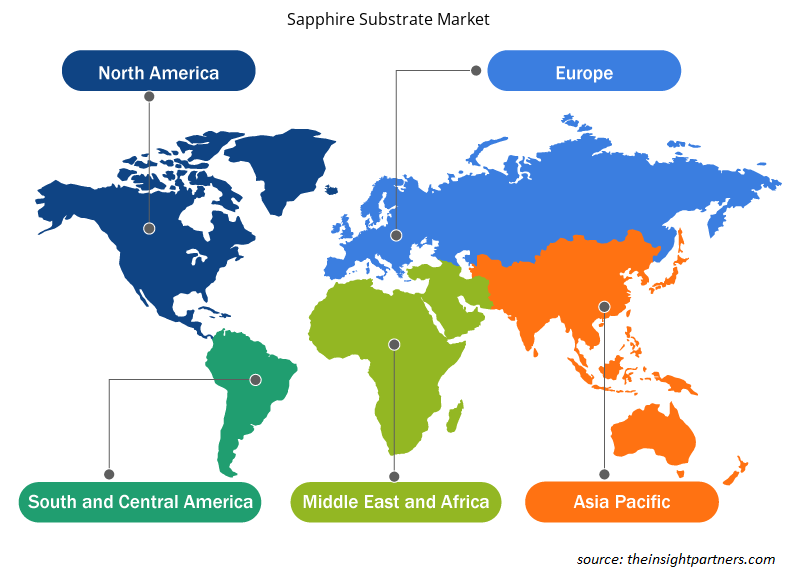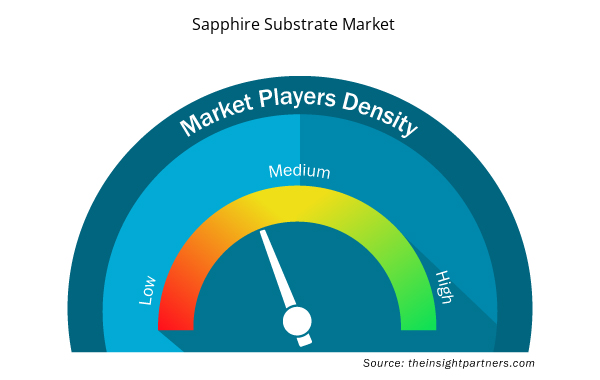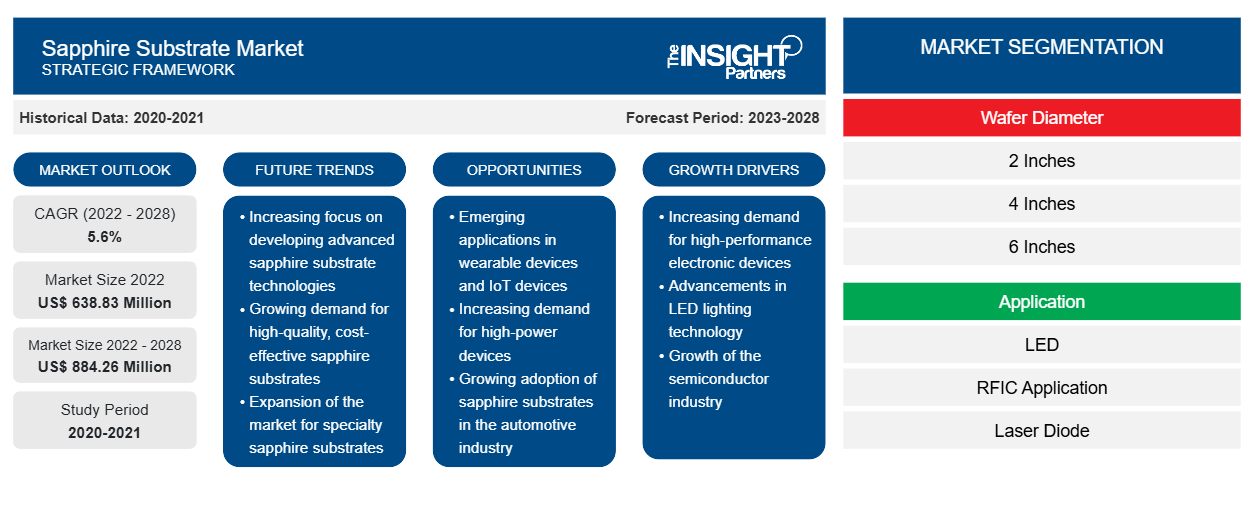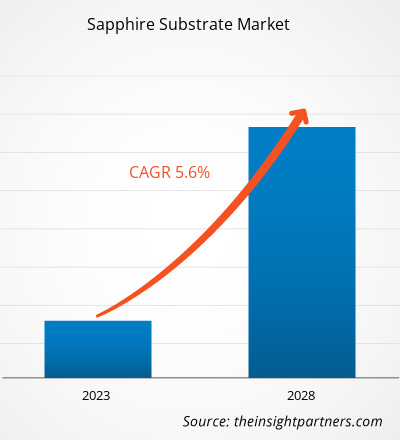Der Markt für Saphirsubstrate soll von 638,83 Millionen US-Dollar im Jahr 2022 auf 884,26 Millionen US-Dollar im Jahr 2028 anwachsen; von 2022 bis 2028 wird ein durchschnittliches jährliches Wachstum von 5,6 % erwartet.
Die Unterhaltungselektronik bietet dem Markt für Saphirsubstrate enorme Wachstumschancen . Hersteller von Smartphones und anderen elektronischen Geräten sind an der Verwendung von Saphirsubstraten interessiert. Angesichts der steigenden Nachfrage nach Unterhaltungselektronik weltweit konzentrieren sich die Hersteller auf die Herstellung von Saphirsubstraten, die in der Unterhaltungselektronik verwendet werden können. Die Akteure auf dem Markt für Saphirsubstrate konzentrieren sich auch auf die Entwicklung farbloser Saphirwafer für LEDs, da farbige Saphirwafer negative Auswirkungen haben. So entwickelten Forscher aus Saudi-Arabien im April 2022 einkristallines Graphen, indem sie Substrate im Wafermaßstab isolierten. Die Forscher halten diese Entwicklung für wichtig, da der Feldeffekt, den Transistoren aus einer aus Saphir gewachsenen einkristallinen Graphenmonoschicht zeigten, hervorragend funktionierte.
In jüngster Zeit ist die Nachfrage nach hochwertigem farblosem Saphir bei LED-Herstellern gestiegen, um Kosten zu senken und die Produktqualität zu verbessern. Daher wird erwartet, dass die Verwendung von farblosem Saphirsubstrat im Prognosezeitraum neue Möglichkeiten für das Wachstum des Saphirsubstratmarktes mit sich bringt. Darüber hinaus wird aufgrund der zunehmenden Bergbauaktivitäten großer Kristalle in verschiedenen Ländern auch das Produktionsniveau von Saphir steigen. Der Saphir wird in bestehende Halbleiterherstellungsprozesse integriert, was zu einer allgemeinen Kostensenkung für das Saphirsubstrat führt.
Passen Sie diesen Bericht Ihren Anforderungen an
Sie erhalten kostenlos individuelle Anpassungen an jedem Bericht, einschließlich Teilen dieses Berichts oder einer Analyse auf Länderebene, eines Excel-Datenpakets sowie tolle Angebote und Rabatte für Start-ups und Universitäten.
- Holen Sie sich die wichtigsten Markttrends aus diesem Bericht.Dieses KOSTENLOSE Beispiel umfasst eine Datenanalyse von Markttrends bis hin zu Schätzungen und Prognosen.
Auswirkungen der COVID-19-Pandemie auf die Marktgröße für Saphirsubstrate
Die COVID-19-Pandemie hat Europa erheblich negativ beeinflusst, was darauf hindeutet, dass das Halbleiter- und Elektronikbudget der Region einen erheblichen Schlag erleiden könnte, während sich die europäischen Volkswirtschaften von dem Ausbruch erholen. Da der COVID-19-Ausbruch die Gesamtbudgets stark beeinträchtigte, reduzierten viele europäische Länder ihre Ausgaben für Elektronik und Halbleiter. Die positiven Auswirkungen auf die Beschaffungsprogramme und Forschungs- und Entwicklungsaktivitäten (F&E) werden den Saphirsubstratmarkt in Europa in den kommenden Jahren voraussichtlich erheblich beeinflussen. Der Sektor der Unterhaltungselektronik in der Europäischen Union wird voraussichtlich im Laufe der Zeit den stärksten Nachfragerückgang und eine größere Leistungslücke erleben, aufgrund der veränderten Nachfragemuster, Geschäftsschließungen, Arbeitslosigkeit und beispiellosen Rückgänge des Bruttoinlandsprodukts (BIP) in vielen Ländern. Der regionale Automobil- und Transportsektor wird voraussichtlich wachsen, da die Regierungen in den kommenden Jahren Anreize für Autokäufer bieten werden.sizeable hit while Europe’s economies recover from the outbreak. Since the COVID-19 outbreak severely impacted overall budgets, many European countries reduced their electronics and semiconductor expenditure. The positive impact on the procurement programs and research & development (R&D) activities is anticipated to significantly affect the sapphire substrate market in Europe in the coming years. The
Dank bedeutender Initiativen von Regierungen und führenden Marktteilnehmern kann sich der Saphirsubstratmarkt der EU von den negativen Auswirkungen der COVID-19-Pandemie erholen. Die EU möchte bis 2030 in die weltweite Spitzenliga der Halbleiterherstellung aufsteigen. Intel plant den Bau einer Halbleiterfabrik im Wert von 20 Milliarden US-Dollar. Europa hat sich in der Lieferkette der Halbleiterindustrie einen festen Platz erobert. Bei der Herstellung von Wafern der Spitzenklasse hinkt es jedoch weit hinter Asien hinterher. Daher investieren die Regierungen des Vereinigten Königreichs, Deutschlands und Frankreichs erheblich in die Halbleitertechnologie und konzentrieren sich auf Partnerschaften und Kooperationen, um den regionalen Markt anzukurbeln. Die Gründung wichtiger Produktionszentren in der EU und der Europäischen Freihandelsassoziation (EFTA), zu der Österreich, Frankreich, Deutschland, Italien, Irland und die Niederlande gehören – alles Länder, in denen mehrere führende Hersteller ansässig sind –, dürfte das Wachstum des europäischen Saphirsubstratmarktes ankurbeln.
Markteinblicke – Saphirsubstratmarkt
Der Markt für Saphirsubstrate wurde von APAC dominiert, gefolgt von Nordamerika, Europa, dem Nahen Osten und Afrika sowie Süd- und Mittelamerika. Die „Big Four“-Halbleiterregionen – Südkorea, Japan, China und Taiwan – haben eine Schlüsselrolle beim Upstream-, Midstream- und Downstream-Wachstum der Halbleiterindustrie gespielt, sogar weltweit. Um in einem so hart umkämpften Umfeld wettbewerbsfähig zu sein und zu florieren, werden die Länder im asiatisch-pazifischen Raum die Geschwindigkeit von F&E und Innovation im Halbleitergeschäft beschleunigen, da die Nachfrage nach Halbleitern wächst und die Diversitätsstandards steigen. Infolgedessen wird der asiatisch-pazifische Raum zum Rückgrat der globalen Halbleiterindustrie. So startete Monocrystal – ein wichtiger Akteur in der Züchtung und Verarbeitung von synthetischem Saphir – im August 2020 ein Projekt zur Herstellung von Saphir-Wafer mit extragroßem Durchmesser für bahnbrechende Leuchtdioden -Anwendungen (LED). Die zwischenstaatliche russisch-chinesische Kommission hat es für die Investitionskooperation genehmigt. Diese Faktoren werden ein enormes Wachstum in der Region fördern und den asiatisch-pazifischen Raum im Prognosezeitraum zu einer wichtigen Region für den Markt für Saphirsubstrate machen.
Anwendungsbasierte Erkenntnisse
Der Markt für Saphirsubstrate ist nach Anwendung in LED, RFIC-Anwendung, Laserdiode und Silizium-auf-Saphir-IC (SOS) und Sonstiges unterteilt. Saphirsubstrate werden bei der Herstellung von Silizium-auf-Wafer verwendet, um hochleistungsfähige Anwendungen für Hochfrequenz-integrierte Schaltkreise (RFIC) herzustellen. Die Verwendung von Saphirsubstraten ist bei LEDs hoch, da sie eine gute elektrische Isolierung und hohe Temperaturbeständigkeit aufweisen. Das LED-Segment führte den Marktanteil der Saphirsubstrate im Jahr 2021 an.
Der Markt für Saphirsubstrate ist nach Waferdurchmesser, Anwendung und Geografie segmentiert. Basierend auf dem Waferdurchmesser ist der Markt in 2 Zoll, 4 Zoll, 6 Zoll und andere segmentiert. Basierend auf der Anwendung ist der Markt in LED, RFIC, Laserdiode und Silizium auf Saphir (SOS) IC und andere segmentiert. Basierend auf der Geografie ist der Markt für Saphirsubstrate hauptsächlich in Nordamerika, Europa, Asien-Pazifik (APAC), den Nahen Osten und Afrika (MEA) sowie Süd- und Mittelamerika segmentiert.
Regionale Einblicke in den Saphirsubstratmarkt
Die regionalen Trends und Faktoren, die den Saphirsubstratmarkt während des Prognosezeitraums beeinflussen, wurden von den Analysten von Insight Partners ausführlich erläutert. In diesem Abschnitt werden auch die Marktsegmente und die Geografie des Saphirsubstratmarkts in Nordamerika, Europa, im asiatisch-pazifischen Raum, im Nahen Osten und Afrika sowie in Süd- und Mittelamerika erörtert.

- Erhalten Sie regionale Daten zum Saphirsubstratmarkt
Umfang des Marktberichts über Saphirsubstrate
| Berichtsattribut | Details |
|---|---|
| Marktgröße im Jahr 2022 | 638,83 Millionen US-Dollar |
| Marktgröße bis 2028 | 884,26 Millionen US-Dollar |
| Globale CAGR (2022 - 2028) | 5,6 % |
| Historische Daten | 2020-2021 |
| Prognosezeitraum | 2023–2028 |
| Abgedeckte Segmente | Nach Waferdurchmesser
|
| Abgedeckte Regionen und Länder | Nordamerika
|
| Marktführer und wichtige Unternehmensprofile |
|
Dichte der Marktteilnehmer für Saphirsubstrate: Die Auswirkungen auf die Geschäftsdynamik verstehen
Der Markt für Saphirsubstrate wächst rasant, angetrieben durch die steigende Nachfrage der Endnutzer aufgrund von Faktoren wie sich entwickelnden Verbraucherpräferenzen, technologischen Fortschritten und einem größeren Bewusstsein für die Vorteile des Produkts. Mit steigender Nachfrage erweitern Unternehmen ihr Angebot, entwickeln Innovationen, um die Bedürfnisse der Verbraucher zu erfüllen, und nutzen neue Trends, was das Marktwachstum weiter ankurbelt.
Die Marktteilnehmerdichte bezieht sich auf die Verteilung der Firmen oder Unternehmen, die in einem bestimmten Markt oder einer bestimmten Branche tätig sind. Sie gibt an, wie viele Wettbewerber (Marktteilnehmer) in einem bestimmten Marktraum im Verhältnis zu seiner Größe oder seinem gesamten Marktwert präsent sind.
Die wichtigsten auf dem Markt für Saphirsubstrate tätigen Unternehmen sind:
- Produktinformationen
- Kyocera Corporation
- Meller Optics, Inc.
- Einkristall
- Rubicon Technology Inc.
Haftungsausschluss : Die oben aufgeführten Unternehmen sind nicht in einer bestimmten Reihenfolge aufgeführt.

- Überblick über die wichtigsten Akteure auf dem Saphirsubstratmarkt
Zu den wichtigsten Akteuren auf dem Markt für Saphirsubstrate gehören Saint-Gobain Group, KYOCERA Corporation, Semiconductor Wafer, Inc., Precision Micro-Optics, Inc. und Crystalwise Technology, Inc..
Die an der Marktstudie zu Saphirsubstraten beteiligten Akteure konzentrieren sich hauptsächlich auf die Entwicklung fortschrittlicher und effizienter Produkte.
- Im Jahr 2022 führte Meller Optics, Inc. eine komplette Palette kleiner hochpräziser Saphir- und Rubinkugeln für den Einsatz in Instrumenten, Messgeräten und anderen Präzisionsmechanismen ein, die reibungsarme Lager, eine lange Lebensdauer und Maßgenauigkeit erfordern.
- Im Jahr 2021 brachte Meller Optics, Inc. maßgeschneiderte Saphirfenster und -kuppeln auf den Markt, die sich zum Schutz von Kameras, Detektoren und Sensoren an militärischen und kommerziellen Drohnen eignen, die für den Einsatz in rauen Umgebungen gebaut sind.
- Historische Analyse (2 Jahre), Basisjahr, Prognose (7 Jahre) mit CAGR
- PEST- und SWOT-Analyse
- Marktgröße Wert/Volumen – Global, Regional, Land
- Branche und Wettbewerbsumfeld
- Excel-Datensatz


- Visualization and 3D Rendering Software Market
- Fill Finish Manufacturing Market
- Analog-to-Digital Converter Market
- Semiconductor Metrology and Inspection Market
- Smart Parking Market
- Automotive Fabric Market
- Aircraft Wire and Cable Market
- Surety Market
- Occupational Health Market
- Digital Language Learning Market

Report Coverage
Revenue forecast, Company Analysis, Industry landscape, Growth factors, and Trends

Segment Covered
This text is related
to segments covered.

Regional Scope
North America, Europe, Asia Pacific, Middle East & Africa, South & Central America

Country Scope
This text is related
to country scope.
Häufig gestellte Fragen
By 2028, the global market size of sapphire substrate market will be USD 884.26 Million.
Mexico, Russia, Germany, India, South Korea, Saudi Arabia are registering a high growth rate during the forecast period.
LED segment held the largest share in sapphire substrate market. The sapphire substrates are mostly used in producing light-emitting diodes (LEDs) due to 3 major reasons: Mechanical strength, flatness, and light transmission.
China holds the major market share of sapphire substrate market in 2022.
Saint-Gobain Group, KYOCERA Corporation, Semiconductor Wafer, Inc., Precision Micro-Optics, Inc., and Crystalwise Technology, Inc. are the five key market players operating in the global sapphire substrate market.
Growing trend of using large LEDs is one of the major trends anticipated to propel the market growth during the forecast period.
Rising uptake of silicon-on-sapphire microelectronic circuits and increasing demand for sapphire substrate in led applications are major driving factors contributing towards the growth of sapphire substrate market.
The global sapphire substrate market was valued USD 638.83 million in 2022.
The List of Companies - Sapphire Substrate Market
- Iljin Display Co. Ltd.
- Kyocera Corporation
- Meller Optics, Inc.
- Monocrystal
- Rubicon Technology Inc.
- Cryscore Optoelectronic Limited
- Precision Micro-Optics Inc.
- Saint Gobain S.A
- Semiconductor Wafer Inc.
- Crystalwise Technology Inc.
The Insight Partners performs research in 4 major stages: Data Collection & Secondary Research, Primary Research, Data Analysis and Data Triangulation & Final Review.
- Data Collection and Secondary Research:
As a market research and consulting firm operating from a decade, we have published and advised several client across the globe. First step for any study will start with an assessment of currently available data and insights from existing reports. Further, historical and current market information is collected from Investor Presentations, Annual Reports, SEC Filings, etc., and other information related to company’s performance and market positioning are gathered from Paid Databases (Factiva, Hoovers, and Reuters) and various other publications available in public domain.
Several associations trade associates, technical forums, institutes, societies and organization are accessed to gain technical as well as market related insights through their publications such as research papers, blogs and press releases related to the studies are referred to get cues about the market. Further, white papers, journals, magazines, and other news articles published in last 3 years are scrutinized and analyzed to understand the current market trends.
- Primary Research:
The primarily interview analysis comprise of data obtained from industry participants interview and answers to survey questions gathered by in-house primary team.
For primary research, interviews are conducted with industry experts/CEOs/Marketing Managers/VPs/Subject Matter Experts from both demand and supply side to get a 360-degree view of the market. The primary team conducts several interviews based on the complexity of the markets to understand the various market trends and dynamics which makes research more credible and precise.
A typical research interview fulfils the following functions:
- Provides first-hand information on the market size, market trends, growth trends, competitive landscape, and outlook
- Validates and strengthens in-house secondary research findings
- Develops the analysis team’s expertise and market understanding
Primary research involves email interactions and telephone interviews for each market, category, segment, and sub-segment across geographies. The participants who typically take part in such a process include, but are not limited to:
- Industry participants: VPs, business development managers, market intelligence managers and national sales managers
- Outside experts: Valuation experts, research analysts and key opinion leaders specializing in the electronics and semiconductor industry.
Below is the breakup of our primary respondents by company, designation, and region:

Once we receive the confirmation from primary research sources or primary respondents, we finalize the base year market estimation and forecast the data as per the macroeconomic and microeconomic factors assessed during data collection.
- Data Analysis:
Once data is validated through both secondary as well as primary respondents, we finalize the market estimations by hypothesis formulation and factor analysis at regional and country level.
- Macro-Economic Factor Analysis:
We analyse macroeconomic indicators such the gross domestic product (GDP), increase in the demand for goods and services across industries, technological advancement, regional economic growth, governmental policies, the influence of COVID-19, PEST analysis, and other aspects. This analysis aids in setting benchmarks for various nations/regions and approximating market splits. Additionally, the general trend of the aforementioned components aid in determining the market's development possibilities.
- Country Level Data:
Various factors that are especially aligned to the country are taken into account to determine the market size for a certain area and country, including the presence of vendors, such as headquarters and offices, the country's GDP, demand patterns, and industry growth. To comprehend the market dynamics for the nation, a number of growth variables, inhibitors, application areas, and current market trends are researched. The aforementioned elements aid in determining the country's overall market's growth potential.
- Company Profile:
The “Table of Contents” is formulated by listing and analyzing more than 25 - 30 companies operating in the market ecosystem across geographies. However, we profile only 10 companies as a standard practice in our syndicate reports. These 10 companies comprise leading, emerging, and regional players. Nonetheless, our analysis is not restricted to the 10 listed companies, we also analyze other companies present in the market to develop a holistic view and understand the prevailing trends. The “Company Profiles” section in the report covers key facts, business description, products & services, financial information, SWOT analysis, and key developments. The financial information presented is extracted from the annual reports and official documents of the publicly listed companies. Upon collecting the information for the sections of respective companies, we verify them via various primary sources and then compile the data in respective company profiles. The company level information helps us in deriving the base number as well as in forecasting the market size.
- Developing Base Number:
Aggregation of sales statistics (2020-2022) and macro-economic factor, and other secondary and primary research insights are utilized to arrive at base number and related market shares for 2022. The data gaps are identified in this step and relevant market data is analyzed, collected from paid primary interviews or databases. On finalizing the base year market size, forecasts are developed on the basis of macro-economic, industry and market growth factors and company level analysis.
- Data Triangulation and Final Review:
The market findings and base year market size calculations are validated from supply as well as demand side. Demand side validations are based on macro-economic factor analysis and benchmarks for respective regions and countries. In case of supply side validations, revenues of major companies are estimated (in case not available) based on industry benchmark, approximate number of employees, product portfolio, and primary interviews revenues are gathered. Further revenue from target product/service segment is assessed to avoid overshooting of market statistics. In case of heavy deviations between supply and demand side values, all thes steps are repeated to achieve synchronization.
We follow an iterative model, wherein we share our research findings with Subject Matter Experts (SME’s) and Key Opinion Leaders (KOLs) until consensus view of the market is not formulated – this model negates any drastic deviation in the opinions of experts. Only validated and universally acceptable research findings are quoted in our reports.
We have important check points that we use to validate our research findings – which we call – data triangulation, where we validate the information, we generate from secondary sources with primary interviews and then we re-validate with our internal data bases and Subject matter experts. This comprehensive model enables us to deliver high quality, reliable data in shortest possible time.


 Holen Sie sich ein kostenloses Muster für diesen Bericht
Holen Sie sich ein kostenloses Muster für diesen Bericht